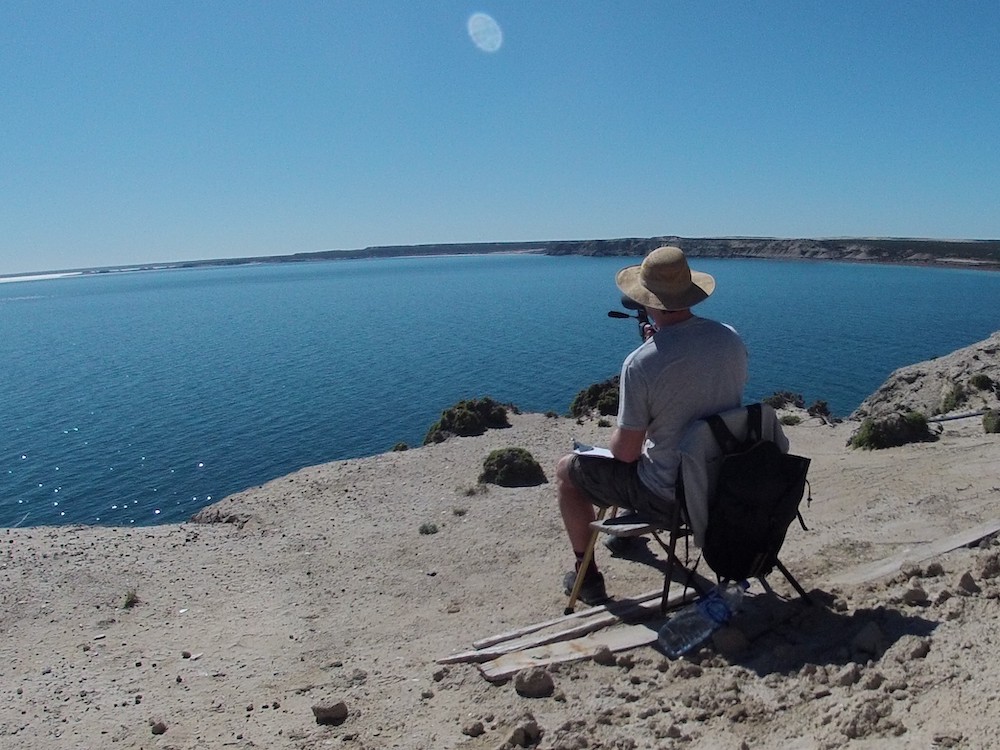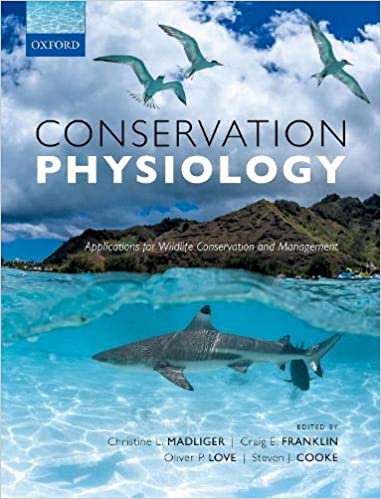Dr. Alejandro A. Fernández Ajó, Postdoctoral Scholar, Marine Mammal Institute – OSU Department of Fisheries, Wildlife, & Conservation Sciences, Geospatial Ecology of Marine Megafauna (GEMM) Lab.
I often receive two reactions when asked what I am currently working on; one is “Wow! That is a very cool job, it must be amazing to work with such incredible animals!”, the other is “How do you do that and why is that important?”. So, today I decided to blog about some of the reasons why it is important to develop a pregnancy test for gray whales and how we are doing this.
In a previous blogpost, I described the many ways in which whales play critical roles in sustaining marine ecosystem. Briefly, whales can enhance marine productivity by vertically and horizontally mixing of ocean waters, promoting primary production, and mitigating climate change by sequestering carbon with their large biomass and long life-span (1-3). Even after they die, their carcasses can contribute to biodiversity creating new habitat on the seafloor (4). But, over several decades, the whaling industry drastically removed whales around the globe, with some species and populations depleted to near extinction (5). Consequently, these depleted whale populations now play a diminished role in ocean ecosystem processes and their recovery is currently challenged by an increasing number of modern anthropogenic impacts. Hence, working towards whale conservation is essential for keeping a healthy marine ecosystem.
Working and designing effective strategies for conservation biology often involves gaining knowledge regarding the reproductive parameters of individual animals in wild populations. This information is critical for understanding population trends and the underlaying mechanisms that affect animal welfare and their potential for recovery. However, getting such information from free-living whales can be challenging (see Hunt et al. 2013). While we know that whales typically have long life-spans, lengthy generation times, extended parental care, and high survival rates, detailed knowledge on the life history and general reproductive biology of free-ranging whales is limited for the majority of the whale populations. In fact, much of what we do know about whale reproduction is derived from whaling records. Only recently, conservation physiology approaches (see our previous post here) have contributed alternative and non-invasive methods for monitoring key physiological processes that can help monitor a whale’s reproductive biology and determine reproductive parameters such as sexual maturity and pregnancy (6-9).
Gray whales (Eschrichtius robustus) in the Eastern North Pacific (ENP) typically undertake annual migrations between their lower latitude breeding grounds in the coastal waters of the Baja California Peninsula, Mexico, and the foraging grounds located on the Bering and Chukchi Seas (10). However, among the ENP whales a distinct subgroup of about 230 whales shorten their migration to feed in the coastal waters of Northern California, Oregon, and southeastern Alaska (11). This group of whales is known as the gray whale Pacific Coast Feeding Group (PCFG).
Since 2016, the GEMM Lab has monitored individual gray whales within the PCFG off the Oregon coast (check the GRANITE project). Gray whales have a distinct mottled skin; and each individual whale presents a unique pigmentation pattern that allows for the individual identification of whales. We can identify who is who among the whales who visit the Oregon coast. In this way, we can keep a detailed record of re-sightings of known individuals (visit our new web site to know more about the lives of individual whales that visit the Oregon coast). We have high individual re-sighting rates, so this unique opportunity helps us keep a long-term data series for individual whales to monitor their health, body condition, and reproductive status over time, and thus further develop and advance our non-invasive study methods.
We are combining behavioral and feeding ecology with drone photogrammetry and endocrinology of the same individual whales to help us understand the relationships between natural and anthropogenic drivers with biological parameters. In this way, following individual whales, we are developing sensitive biomarkers to monitor and infer about the population health, population trends, and identify stressors that impact their recovery and welfare. In particular, we are now working to develop a noninvasive approach to detect pregnancy in gray whales based on fecal hormone analyses.

In marine mammals, the progesterone hormone is secreted in the ovaries during the estrous cycle and gestation, and is the predominant hormone responsible for sustaining pregnancy (12). As the hormones are cleared from the blood into the gut, they are metabolized and eventually excreted in feces; fecal samples represent a cumulative and integrated concentration of hormone metabolites (13-14), which are useful indicators for endocrine assessments of free-swimming whales. Several studies show that changes in hormone concentration correlate in meaningful ways with exposure to stressors (15-16) and changes in reproductive status (17-19). We are using our long data series of fecal hormones and individual life histories to advance our understanding on the gray whales’ reproductive biology. We are close to developing a technique that will allow us to detect pregnancy in whales based in fecal hormones analyses and photogrammetry. Stay tuned for results from this pregnancy test!
Did you enjoy this blog? Want to learn more about marine life, research, and conservation? Subscribe to our blog and get a weekly alert when we make a new post! Just add your name into the subscribe box on the left panel.
References:
1- Pershing AJ, Christensen LB, Record NR, Sherwood GD, Stetson PB (2010) The impact of whaling on the ocean carbon cycle: Why bigger was better. PLoS ONE 5(8): e12444.
2- Roman J and McCarthy JJ. 2010. The whale pump: marine mammals enhance primary productivity in a coastal basin. PLoS ONE. 5(10): e13255.
3- Morissette L, Kaschner K, and Gerber LR. 2010. “Whales eat fish”? Demystifying the myth in the Caribbean marine ecosystem. Fish Fish 11: 388–404.
4- Smith CR, Roman J, Nation JB. A metapopulation model for whale-fall specialists: The largest whales are essential to prevent species extinctions. J. Mar. Res. 77, 283–302 (2019).
5- Branch TA, Williams TM. Legacy of industrial whaling. Whales. Whal. Ocean Ecosyst. 2006, 262–278 (2006).
6- Kellar NM, Keliher J, Trego ML, Catelani KN, Hanns C, George JC, et al. Variation of bowhead whale progesterone concentrations across demographic groups and sample matrices. Endanger Species Res 2013; 22:61–72. https://doi.org/10.3354/esr00537.
7- Pallin L, Robbins J, Kellar N, Berube M, Friedlaender A. Validation of a blubber-based endocrine pregnancy test for humpback whales. Conserv Physiol 2018;6:1 11. https://doi.org/10.1093/conphys/coy031PMID:29942518.
8-Hunt KE, Robbins J, Buck CL, Bérubé M, Rolland RM (2019) Evaluation of fecal hormones for noninvasive research on reproduction and stress in humpback whales (Megaptera novaeangliae). Gen Comp Endocrinol 280: 24–34.
9-Melica, V., Atkinson, S., Calambokidis, J., Lang, A., Scordino, J., & Mueter, F. (2021). Application of endocrine biomarkers to update information on reproductive physiology in gray whale (Eschrichtius robustus). Plos one, 16(8), e0255368.
10-Swartz SL. Gray Whale. In: Wursig B, Thewissen JGM, Kovacs KM, editors. Encyclopedia of Marine Mammals (Third Edition). Elsevier;2018,p. 422–8.https://doi.org/10.1016/B978-0-12-804327-1.00140–0.
11-Calambokidis J, Darling JD, Deecke V, Gearin P, Gosho M, Megill W, et al. Abundance, range and movements of a feeding aggregation of gray whales (Eschrichtius robustus) from California to south-eastern Alaska in 1998. J Cetacean Res Manag 2002;4:267–76.
12- Bronson, F. H. (1989). Mammalian reproductive biology. University of Chicago Press.
13-Wasser SK, Hunt KE, Brown JL, Cooper K, Crockett CM, Bechert U, Millspaugh JJ, Larson S, Monfort SL (2000) A generalized fecal glucocorticoid assay for use in a diverse array of nondomestic mammalian and avian species. Gen Comp Endocrinol120:260–275.
14- Hunt, K.E., Rolland, R.M., Kraus, S.D., Wasser, S.K., 2006. Analysis of fecal glucocorticoids in the North Atlantic right whale (Eubalaena glacialis). Gen. Comp. Endocrinol. 148, 260–272. https://doi.org/10.1016/j.ygcen.2006.03.01215.
15- Lemos, L.S., Olsen, A., Smith, A., Burnett, J.D., Chandler, T.E., Larson, S., Hunt, K.E., Torres, L.G., 2021. Stressed and slim or relaxed and chubby? A simultaneous assessment of gray whale body condition and hormone variability. Mar. Mammal Sci. 1–11. https://doi.org/10.1111/mms.12877
16- Rolland, R., McLellan, W., Moore, M., Harms, C., Burgess, E., Hunt, K., 2017. Fecal glucocorticoids and anthropogenic injury and mortality in North Atlantic right whales Eubalaena glacialis. Endanger. Species Res. 34, 417–429. https://doi.org/10.3354/esr00866.
17-Rolland, R.M., Hunt, K.E., Kraus, S.D., Wasser, S.K., 2005. Assessing reproductive status of right whales (Eubalaena glacialis) using fecal hormone metabolites. Gen. Comp. Endocrinol. 142, 308–317. https://doi.org/10.1016/j.ygcen.2005.02.002
18- Valenzuela Molina M, Atkinson S, Mashburn K, Gendron D, Brownell RL. Fecal steroid hormones reveal reproductive state in female blue whales sampled in the Gulf of California, Mexico. Gen Comp Endocrinol 2018;261:127–35.https://doi.org/10.1016/j.ygcen.2018.02.015 PMID:29476760.
19- Hunt, K. E., Robbins, J., Buck, C. L., Bérubé, M., & Rolland, R. M. (2019). Evaluation of fecal hormones for noninvasive research on reproduction and stress in humpback whales (Megaptera novaeangliae). General and Comparative Endocrinology, 280, 24-34.



